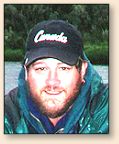|
| ||

Can You Read A Lake?By Mike (Doc) Monteith
|
Every year more people are heading out to
local trout lakes and ponds in search of
cooperative trout. Float tubes and pontoon
boats are now quite common and they no longer
get as many head turns and pointed fingers
they once did. The reason for the growing
number of fly anglers is simple. Convenience.
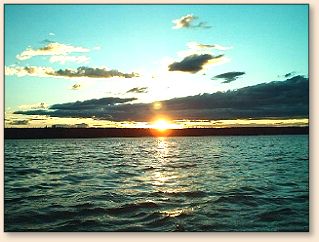 Most cities and towns throughout North America
can find trout lakes and ponds fairly close to
home. These Stillwater fisheries may be privately
stocked pay and play lakes or state/provincially
stocked waters. For a good number of fly anglers,
these waters are closer than their nearest streams
and the convenience of these fisheries is not being
over looked.
Most cities and towns throughout North America
can find trout lakes and ponds fairly close to
home. These Stillwater fisheries may be privately
stocked pay and play lakes or state/provincially
stocked waters. For a good number of fly anglers,
these waters are closer than their nearest streams
and the convenience of these fisheries is not being
over looked.Although newly stocked trout (stockers) are fairly easy to catch, many anglers report that the larger trout in these Stillwater fisheries are hard to find and not as cooperative as they should be. Or maybe it's that the average fly angler doesn't know where to look. Fishing a lake or a stream can be difficult and will create complications, especially for novices. Leader shy trout will require you to have just the right size tippet when casting a dry fly. Closely matching the hatch with the right pattern and size of fly can be an issue for fussy trout. And there may be no hatch coming off at all - at least not one that's obvious - leaving you with the decision of what nymphs (wet flies) to use. How well you present your fly to selective trout and where to cast your fly can also have a huge impact on your success. There can be many problems an angler must work into the trout equation but with practice comes experience and secrets are soon revealed. To achieve positive results, reading the water on a lake or stream is a secret best discovered sooner than later and knowing where trout are holding or at least where they should be holding really is half the battle. Lakes and ponds however, are considerably different than streams and 'reading' still water fisheries can be intimidating for new fly anglers and even some seasoned stream veterans. So how do you read a lake where there are no obvious fast riffles, deep runs or fish-holding boulders? There may be no obvious structure like in a stream, but there is structure even if it is in a different form. And like fishing streams, with practice, lake fly anglers can learn where the high probability and prime holding areas are in the Stillwater's they fish. A prime lie in a stream would be considered anywhere that the trout can find food, shelter from predators and suitable levels of oxygen (comfort zone). These are the three basic necessities of trout and the same needs must be met in a lake or pond. One primary difference between streams and lakes is that trout in streams tend to hold in one place waiting for food to come to them. However, in lakes, trout cruise around looking for food in specific, prime areas, and these are the places you'll want to concentrate on. Stillwater trout search for most of their food at the drop-offs and shoal areas. But what are drop-offs, what are shoals and how does a lake fly angler find them?
The shoal and drop-off transition is an important structure for fish-and for anglers. Aquatic insects and small forage fish will frequently move near and even beyond or down the drop-off area making easy meals for searching trout. This is what I like to refer to as the 'Strike Zone' and it's where you'll get most of your strikes and hook-ups on your flies. Anglers fishing these structures with sub-surface patterns are best to experiment with medium to fast sink lines or sink tips and floating lines with added weight.
Another structure that is highly overlooked when Stillwater fishing is along the shoreline. A lot of aquatic life forms are found very close to the shoreline in very shallow water including Water boatmen, Scuds and Leeches. Although you will find these life forms throughout the lake, concentrations will be much higher close to the shorelines. In low light conditions trout will be less cautious and feed in these areas due to the large number of bugs here. It's not uncommon to arrive at a body of water at first light and see trout swirling only a few feet away from the shore. On windy days, it's in the angler's best interest to head over to the shoreline being pounded by the wind driven waves. These waves will not only give the trout a choppy cover from predators but will also stir up insects from the bottom and force then into these shorelines. A floating line or a slow sinking line will produce well along shorelines while keeping your fly from consistently picking up weeds and debris. The deeper sections of a lake will also see trout. On hot summer days you'll find trout moving deeper where conditions are cooler and more oxygen rich, feeding on Bloodworms, Chironomids (Midges), Dragonfly nymphs and other aquatic life forms but oxygen levels usually dictate how deep fish will hold. A section of a lake may be 50 feet deep but trout may only hold as far as thirty feet if the water below that depth is anoxic. A full sink line, fast sink tip or a floating line with a long leader, strike indicator and a weighted fly will do you well in these deeper waters. For years Chironomid fishing with a strike indicator has been the preferred method for BC's Stillwater anglers and is now becoming very popular throughout North America. Originating in the U.K., the preferred method of Chironomid fishing consists of using a floating line with or without a strike indicator and enough leader to set your lightly weighted Chironomid at its desired depth, usually between eight and 25 feet. The retrieve (if you want to call it that) is one or two short pulls or a very slow hand twist, then wait. Just when you think your fly has fallen back to the desired depth, wait some more. Now another short pull or twist and repeat. The retrieve -drop-and-wait- is repeated until the line comes in and a new cast is made. Fishing with Bloodworm, Scud and Leech patterns are also very affective using the Chironomid method of fly-fishing and fishing Bloodworms in deeper water and Scuds in shallow water should generate strikes. On slow days when the fish are less active, less movement of your fly is best. Sometimes it takes no movement at all to be successful but this method will produce more often then not. The problem of no fish days is usually the fault of the angler as this method of fishing can be (at times) as much fun as watching paint dry. Anglers don't always have the patience to leave the fly sit still long enough without retrieving it therefore giving a poor presentation. Chironomids horizontally make their way to the surface very slowly in an upward and then downward motion. Another common mistake by anglers is not experimenting enough with different depths to find where the fish are holding. When the trout are less active, they may not want to move from their comfort zone to eat your presentation. There are usually many Chironomids for the trout to feed on right where they are.
Like stream fishing, reading the water and knowing where the fish are holding is half the battle and being able to read a lake will at the very least have you fishing in high probability areas at your local fishin' hole. ~ Doc
About the author:Mike (Doc) Monteith is the owner/guide of Edmonton Float Tube Adventures, owner of the information web site Fly Fishing Edmonton and editor/publisher of the information web site Float Tube Fly Fishing.
|
|
Previous Lake Fishing Columns If you would like to comment on this or any other article please feel free to post your views on the FAOL Bulletin Board! 
|
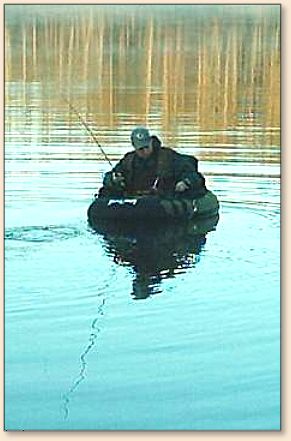 A drop-off is the part of the lake bottom that,
well, like the name implies, drops off. From
the shoreline to the drop-off, you will find
a shallow area known as the shoal. Usually
somewhat weedy, the shoal is home to many
insects like Dragonfly nymphs and Scuds as
well as aquatic life including minnows and
leeches. The trout will swim up from the
drop-off, feed on the shoal and drop back
down again. According to the amount of light,
how warm the water is and how much weed cover
a trout has on the shoal will usually dictate
when and how much time a trout will spend in
the shoal area. The shoal is quite shallow
making it to easy for predators, like Osprey,
to see trout. And trout being as cautious as
they are will not stay on the shoal for very
long. During the day, trout will usually make
quick shopping trips onto the shoal them drop
back down the drop-off. The water in the shoal
area can also be very warm and uncomfortable
for the trout, which will also make trips to
the shoal quick. It's in the evening, throughout
the night and early mornings as well as cool
overcast days that we'll see trout spending
more time in these shoal areas feeding. Autumn
will also see trout spending more time on the
shoals fattening up for winter. And early
spring after ice-out will see trout in these
shallow areas, as the water in the shoal area
will warm up faster increasing insect activity
quicker than in the deeper, colder sections of
the lake. Sometimes when there is a lot of
insect activity like the late spring Damselfly
migration, the trout will throw caution to the
wind and hang on the shoal feeding for long
periods of time even on bright, sunny, warm days.
A drop-off is the part of the lake bottom that,
well, like the name implies, drops off. From
the shoreline to the drop-off, you will find
a shallow area known as the shoal. Usually
somewhat weedy, the shoal is home to many
insects like Dragonfly nymphs and Scuds as
well as aquatic life including minnows and
leeches. The trout will swim up from the
drop-off, feed on the shoal and drop back
down again. According to the amount of light,
how warm the water is and how much weed cover
a trout has on the shoal will usually dictate
when and how much time a trout will spend in
the shoal area. The shoal is quite shallow
making it to easy for predators, like Osprey,
to see trout. And trout being as cautious as
they are will not stay on the shoal for very
long. During the day, trout will usually make
quick shopping trips onto the shoal them drop
back down the drop-off. The water in the shoal
area can also be very warm and uncomfortable
for the trout, which will also make trips to
the shoal quick. It's in the evening, throughout
the night and early mornings as well as cool
overcast days that we'll see trout spending
more time in these shoal areas feeding. Autumn
will also see trout spending more time on the
shoals fattening up for winter. And early
spring after ice-out will see trout in these
shallow areas, as the water in the shoal area
will warm up faster increasing insect activity
quicker than in the deeper, colder sections of
the lake. Sometimes when there is a lot of
insect activity like the late spring Damselfly
migration, the trout will throw caution to the
wind and hang on the shoal feeding for long
periods of time even on bright, sunny, warm days.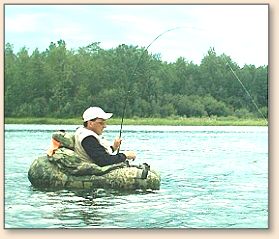 Weed beds are another important structure for
fish and anglers. Like the weed cover we see
in the shoal areas, mid-lake weed beds also
hold insects and aquatic life forms and give
good cover to cruising trout. Anglers will
often find large numbers of trout at anytime
of day searching for food here even when the
water is quite warm. You can find weed beds
in many different areas of a Stillwater fishery,
many times right in the middle of the lake.
Mid-lake weed beds usually grow on humps where
the water is relatively shallow, quite often
giving us smaller drop-offs to fish. Some
weed beds can be seen from the surface and
some are sub surface. You can have many days
fishing weed beds with unbelievable catch rates
by just concentrating on this structure alone.
Leech, Damselfly nymph and many dry fly patterns
work incredibly well when casting around the
edges, directly into or overtop of these weed
beds. A slow or medium sink line as well as
a floating line with or without added weight
will all work well here according to what bugs
the trout are keyed on to.
Weed beds are another important structure for
fish and anglers. Like the weed cover we see
in the shoal areas, mid-lake weed beds also
hold insects and aquatic life forms and give
good cover to cruising trout. Anglers will
often find large numbers of trout at anytime
of day searching for food here even when the
water is quite warm. You can find weed beds
in many different areas of a Stillwater fishery,
many times right in the middle of the lake.
Mid-lake weed beds usually grow on humps where
the water is relatively shallow, quite often
giving us smaller drop-offs to fish. Some
weed beds can be seen from the surface and
some are sub surface. You can have many days
fishing weed beds with unbelievable catch rates
by just concentrating on this structure alone.
Leech, Damselfly nymph and many dry fly patterns
work incredibly well when casting around the
edges, directly into or overtop of these weed
beds. A slow or medium sink line as well as
a floating line with or without added weight
will all work well here according to what bugs
the trout are keyed on to.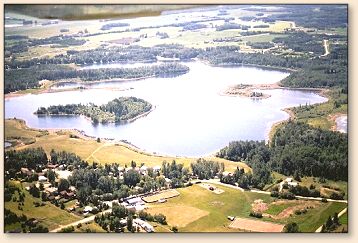 I guess the biggest problem anglers have while
trying to find structure is seeing it. Of
course you can't see a lot of structure when
it's underwater, or how deep the section of
water is that you may be fishing. The
shoreline of a lake however, can give away
some secrets about what's under the surface.
Try and study the contour of the shoreline.
These land features often continue below
the water. A steep bank at the shoreline
usually means a quick drop-off and a very
flat shoreline usually continues on that way
well below the surface. Also look for clusters
of stumps, downed logs, brush piles, river and
creek mouths or other signs that may look like
fishy hangouts. Try getting a hold of some
depth charts or hydrographic maps of the lake
you wish to fish as these maps can either
confirm or contest what the shoreline is
telling you and will also give you an idea
where you can find deep holes, underwater
humps, shallow flats and old river or creek
channels. Also consider purchasing a fish
finder or depth finder. A fish finder is a
great way to find depth and structure in a
lake and can easily be attached to your float
tube or pontoon boat with a homemade or
commercially available bracket kit. The small
gel cell batteries needed to power these units
will easily fit in the storage pockets on your
tube and there is no need to get anything
expensive, as even the cheapest units will
have the two most important features, depth
and bottom structure.
I guess the biggest problem anglers have while
trying to find structure is seeing it. Of
course you can't see a lot of structure when
it's underwater, or how deep the section of
water is that you may be fishing. The
shoreline of a lake however, can give away
some secrets about what's under the surface.
Try and study the contour of the shoreline.
These land features often continue below
the water. A steep bank at the shoreline
usually means a quick drop-off and a very
flat shoreline usually continues on that way
well below the surface. Also look for clusters
of stumps, downed logs, brush piles, river and
creek mouths or other signs that may look like
fishy hangouts. Try getting a hold of some
depth charts or hydrographic maps of the lake
you wish to fish as these maps can either
confirm or contest what the shoreline is
telling you and will also give you an idea
where you can find deep holes, underwater
humps, shallow flats and old river or creek
channels. Also consider purchasing a fish
finder or depth finder. A fish finder is a
great way to find depth and structure in a
lake and can easily be attached to your float
tube or pontoon boat with a homemade or
commercially available bracket kit. The small
gel cell batteries needed to power these units
will easily fit in the storage pockets on your
tube and there is no need to get anything
expensive, as even the cheapest units will
have the two most important features, depth
and bottom structure.